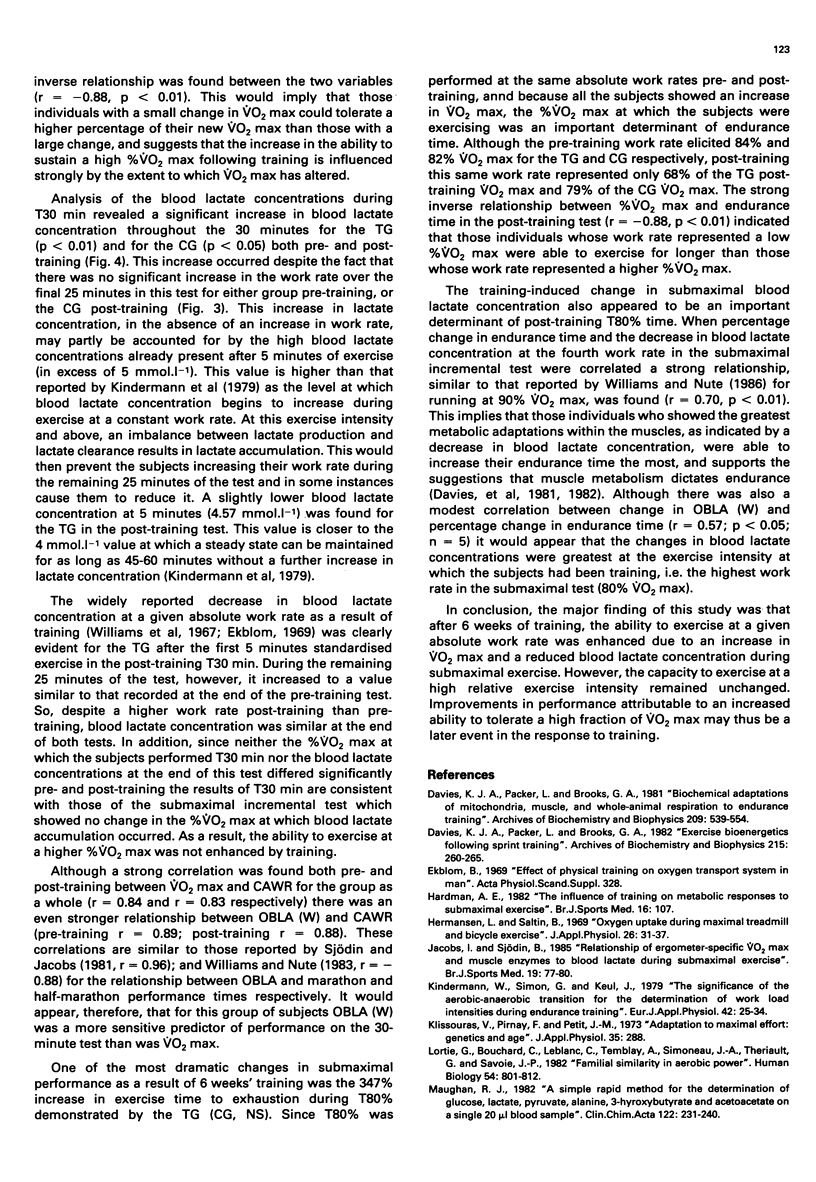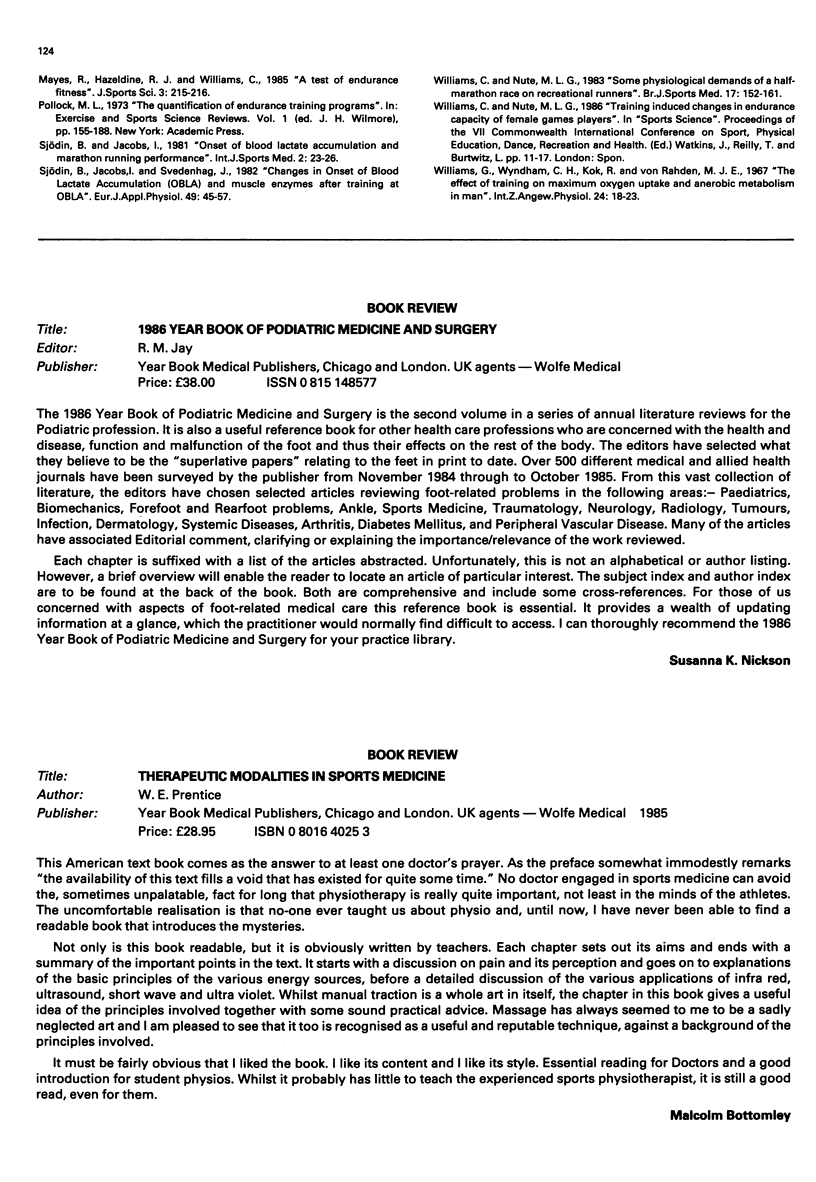Abstract
The purpose of this study was to examine the effect of short-term training on maximum oxygen uptake (VO2 max) and two different measures of endurance performance. Endurance was determined for 15 female subjects (7 training, 8 control) as (1) exercise time to exhaustion at 80% VO2 max (T80%) and (2) the highest relative exercise intensity tolerable during a 30-minute test (T30 min), before and after a 6-week training period. In addition, VO2 max and the work rate equivalent to a blood lactate concentration of 4 mmol.l-1 (OBLA) were determined. Maximum oxygen uptake increased by 24% (p less than 0.01) for the training group (TG) and 7% (p less than 0.01) for the control group (CG). Cumulative average work rate (CAWR) during T30 min increased by 25% for the TG while there was no change for the CG. No significant difference was found pre- and post-training in the %VO2 max (estimated from CAWR) at which the TG and CG performed T30 min. Exercise time to exhaustion on T80% increased by 347% (p less than 0.01) and 16% (NS) for the TG and the CG respectively. Good correlations were found between VO2 max and CAWR (W) (pre-training r = 0.84; post-training r = 0.83), OBLA (W) and CAWR (W) (pre-training r = 0.89; post-training r = 0.88) and change in endurance time and the change in submaximal blood lactate concentration (r = 0.70, p less than 0.01). The results of this study suggest that the ability to sustain a high relative exercise intensity is not enhanced following short-term training.
Full text
PDF





Selected References
These references are in PubMed. This may not be the complete list of references from this article.
- Davies K. J., Packer L., Brooks G. A. Biochemical adaptation of mitochondria, muscle, and whole-animal respiration to endurance training. Arch Biochem Biophys. 1981 Jul;209(2):539–554. doi: 10.1016/0003-9861(81)90312-x. [DOI] [PubMed] [Google Scholar]
- Davies K. J., Packer L., Brooks G. A. Exercise bioenergetics following sprint training. Arch Biochem Biophys. 1982 Apr 15;215(1):260–265. doi: 10.1016/0003-9861(82)90303-4. [DOI] [PubMed] [Google Scholar]
- Hermansen L., Saltin B. Oxygen uptake during maximal treadmill and bicycle exercise. J Appl Physiol. 1969 Jan;26(1):31–37. doi: 10.1152/jappl.1969.26.1.31. [DOI] [PubMed] [Google Scholar]
- Jacobs I., Sjödin B. Relationship of ergometer-specific VO2 max and muscle enzymes to blood lactate during submaximal exercise. Br J Sports Med. 1985 Jun;19(2):77–80. doi: 10.1136/bjsm.19.2.77. [DOI] [PMC free article] [PubMed] [Google Scholar]
- Kindermann W., Simon G., Keul J. The significance of the aerobic-anaerobic transition for the determination of work load intensities during endurance training. Eur J Appl Physiol Occup Physiol. 1979 Sep;42(1):25–34. doi: 10.1007/BF00421101. [DOI] [PubMed] [Google Scholar]
- Klissouras V., Pirnay F., Petit J. M. Adaptation to maximal effort: genetics and age. J Appl Physiol. 1973 Aug;35(2):288–293. doi: 10.1152/jappl.1973.35.2.288. [DOI] [PubMed] [Google Scholar]
- Lortie G., Bouchard C., Leblanc C., Tremblay A., Simoneau J. A., Thériault G., Savoie J. P. Familial similarity in aerobic power. Hum Biol. 1982 Dec;54(4):801–812. [PubMed] [Google Scholar]
- Maughan R. J. A simple, rapid method for the determination of glucose, lactate, pyruvate, alanine, 3-hydroxybutyrate and acetoacetate on a single 20-mul blood sample. Clin Chim Acta. 1982 Jul 1;122(2):231–240. doi: 10.1016/0009-8981(82)90282-0. [DOI] [PubMed] [Google Scholar]
- Sjödin B., Jacobs I. Onset of blood lactate accumulation and marathon running performance. Int J Sports Med. 1981 Feb;2(1):23–26. doi: 10.1055/s-2008-1034579. [DOI] [PubMed] [Google Scholar]
- Sjödin B., Jacobs I., Svedenhag J. Changes in onset of blood lactate accumulation (OBLA) and muscle enzymes after training at OBLA. Eur J Appl Physiol Occup Physiol. 1982;49(1):45–57. doi: 10.1007/BF00428962. [DOI] [PubMed] [Google Scholar]
- Williams C. G., Wyndham C. H., Kok R., von Rahden M. J. Effect of training on maximum oxygen intake and on anaerobic metabolism in man. Int Z Angew Physiol. 1967;24(1):18–23. doi: 10.1007/BF00693572. [DOI] [PubMed] [Google Scholar]
- Williams C., Nute M. L. Some physiological demands of a half-marathon race on recreational runners. Br J Sports Med. 1983 Sep;17(3):152–161. doi: 10.1136/bjsm.17.3.152. [DOI] [PMC free article] [PubMed] [Google Scholar]


